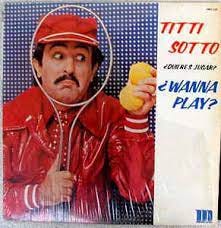Miami Sound Before (& After) The Machine
On Carlos Oliva and Titti Sotto, two titans of the fine print.....
Every music scene has a backstory. And, usually, a deep bench.
Sometimes the consequential players are not the names on the marquee – given the sorry state of credits in the digital realm, it’s routine to run across influential figures whose contributions have become partially obscured over time. Woe visits the researcher trying to determine who played bass on a small-label record made in the late 1970s.
That’s the case with the Latin soul music that erupted in New York in the 1960s. This boomlet started small and kitschy, and grew into a language of its own, one borrowed by pop singers and jazz musicians eager to “cross over.” It was refined in live performance mostly, by nightly gig doers who made those rhythms sound urgent and effortless at the same time. The musicians who contributed to this evolution were not all big names or even medium-sized names; many recorded only occasionally. Their effort lives in the DNA of the music that came after them.
This particular type of obscurity is a fact of life in music, affecting major waves (the British Invasion had a long undercard) and narrower, less pervasive trends. Listening to concentrated doses of clave-based boogaloo this past week, I couldn’t help but think back to the late ‘70s and early ‘80s in Miami, where a group of talented singers and musicians developed an insanely catchy form of Latin dance music.
Most people who were around in the ‘80s have it (perhaps involuntarily) burned into their memory banks via “Conga” and other hit singles by Miami Sound Machine.
The Miami Sound Machine was wicked hot in its earliest incarnation, and only got more accomplished during its chart-topping run. [Disclosure statement: I went to music school and remain friends with many of the musicians recruited by Gloria and Emilio Estefan for the Sound Machine, and played in far less successful pop-leaning salsa bands emulating MSM on the South Florida club circuit during the early ‘80s.]
But: Miami Sound Machine wasn’t the beginning or the end of the “Miami Sound.” The musical style itself – which incorporates elements of samba (basslines!) and rock (electric guitars!) and jazz harmony – started percolating a few years before. It was largely the brainchild of Cuba-born singer, songwriter and producer Carlos Oliva and a team of studio veterans including arranger Frankie Marcos. Fronting a sophisticated band he called Los Sobrinos del Juez (The Judges’ Nephews), Oliva smoothed over the intensity of Fania-style salsa, and wrote songs that usually had at least one, sometimes several, high-wattage hooks. As an artist, Oliva has pursued his contagion for decades, with various configurations of his band; his most recent single, “La Loteria,” was released in July.
Oliva’s basic recipe – repetitive, easy-to-sing pop refrains situated within a gently surging rhythm-forward mix – spread to pretty much everyone making records in Miami. It influenced the gifted songwriter Titti Sotto, who crafted some of Cuban singer and bandleader Willie Chirino’s most addictive early hits. It influenced the charanga duo Hansel Y Raul, who moved from New York to Miami and shortly thereafter embraced the sound with a song that became inescapable on local radio: “Todo El Mundo Con La Lengua Afuera.” That song, on the attached playlist, is like many of the Miami Sound highlights: More celebratory than musically intense, it zooms right past academic concerns of genre and language to burrow directly in the pleasure center of the brain.
Oliva produced several early Miami Sound Machine records including the 1978 breakthrough “Quiereme.” It’s unfortunate that his other productions from this period have become difficult to find, because they show how relentlessly bouyant the Miami Sound blend could be. Among the strongest examples: Clouds’ disco-leaning 1980 hit “Hay Carino” and the brilliantly arranged traditional salsa debut of pianist Hernan Gutierrez. (Sadly, the Spotify version of the entertaining Hay Carino album sounds like it was transferred from vinyl.)
For years after Sotto died in 1992, Chirino performed a homage, in medley form, to the composer of his key early hits. This shortchanged the diabolic structural genius of Sotto’s writing: His songs, like Oliva’s, pack hook on top of hook, utilizing elements of classic salsa (call-and-response mambos, etc.) as sections in songs that are better understood as elaborate pop productions. “El Collar de Clodomiro” and “Lo Que Esta Pa Ti” are represented here, but there are many others. And Chirino incorporated Sotto’s tricks into his craft ever since: Among his more recent artistic triumphs is the blazing merengue-meets-Afrobeat “Dejate Quierer” from 1995.
The playlist includes songs Sotto wrote for stars like Celiz Cruz, and ends with a recent update of the Miami Sound from a band called Palo!, led by longtime Chirino producer and collaborator Steve Roitstein. It’s one among several currently active projects that embrace — and extend — the ideas of Carlos Oliva and Titti Sotto, two titans of the small print.
Why yes, we have a fancy digital suggestion box. Share your favorite Underloved/Overlooked records here: echolocatormusic@gmail.com.
Please consider subscribing (it’s free!). And…..please spread the word! (This only works via word of mouth!)






